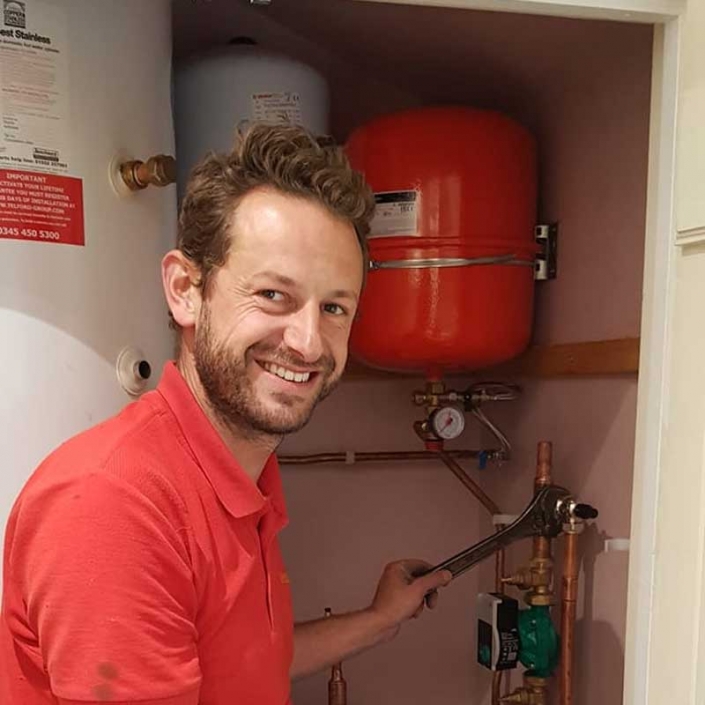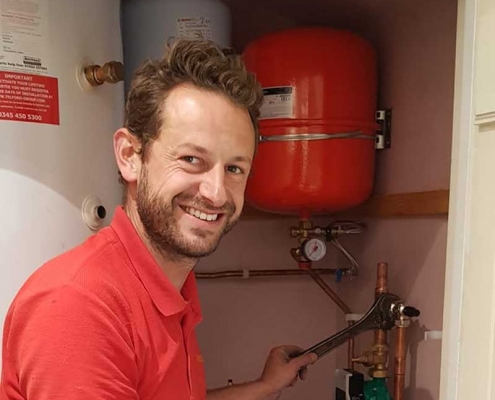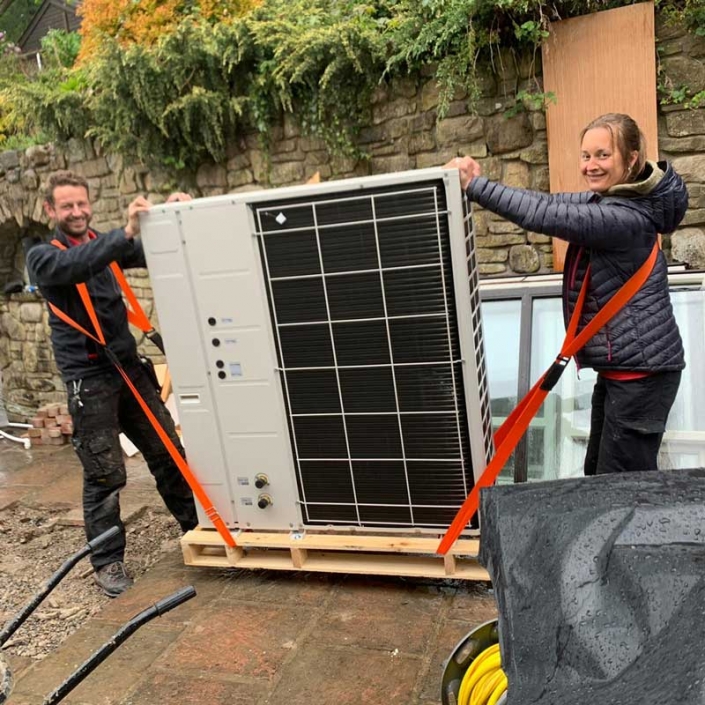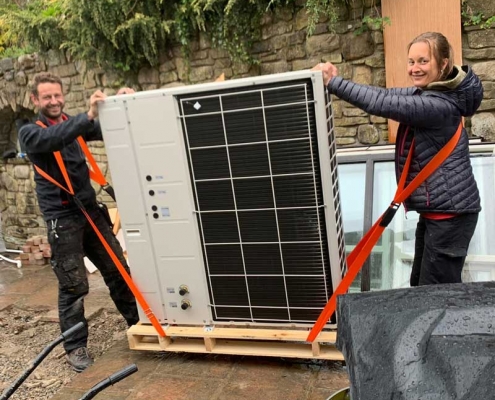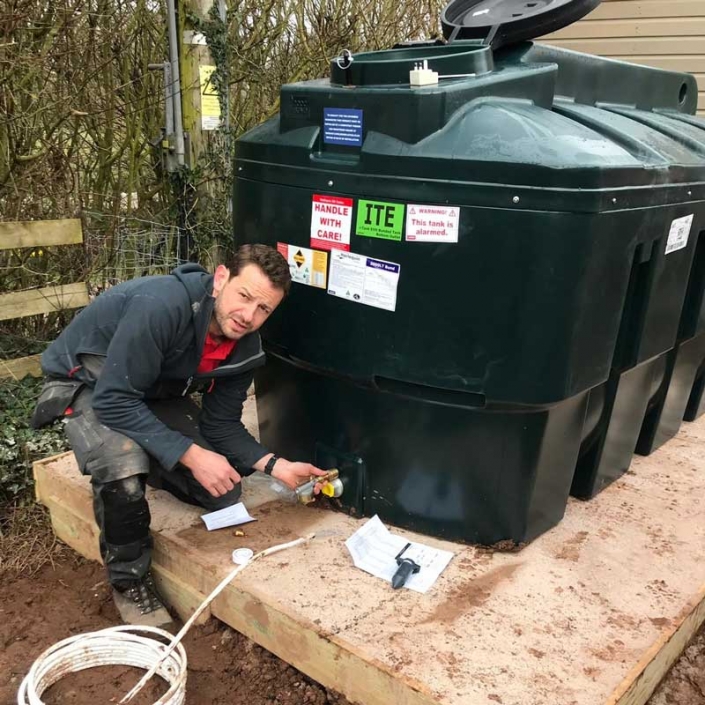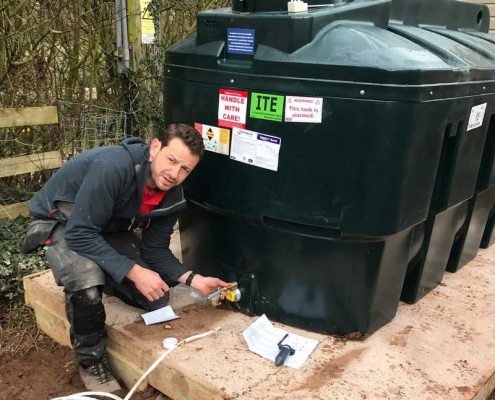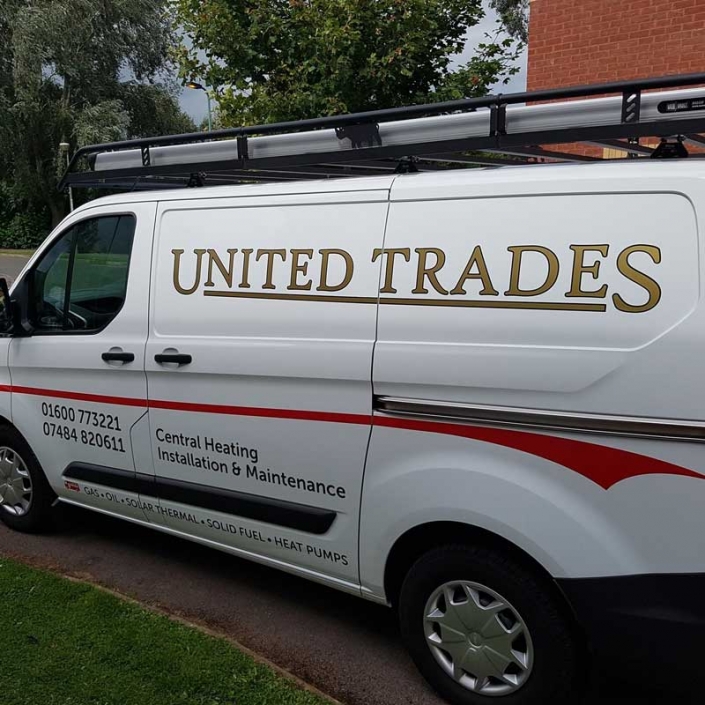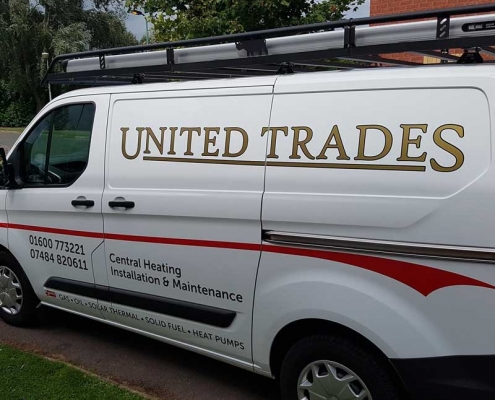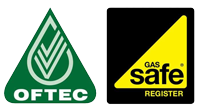Resources.
Explaining heat pumps
Heat pumps
There are two types of heat pumps, air and ground. A heat pump uses a small amount of electricity but transfers heat energy instead of treating it like a traditional boiler, making it an efficient and green source of heat. Amazingly these pumps can extract heat from outside air as long as it’s above -18c.
Air source heat pumps
Air source heat pumps extract heat from ambient external air through an appliance fitted to the outside of a house. The heat from the air is absorbed into a refrigerant fluid and passed through a heat exchanger to heat water. This water is in turn used to heat the domestic hot water and central systems. The cycle works like this:
- Evaporator – this is a heat exchanger which takes heat from the air and transfers it to the refrigerant circuit. Warm air is drawn over the evaporator via a large fan. The refrigerant alters from a liquid to a gas within the evaporator and is at a low pressure, warm temperature as it enters the evaporator.
- Compressor – this compresses the warm temperature, low-pressure gas into a high-pressure gas which increases its temperature. The compressor, coupled with the expansion valve creates a suction effect, enabling the refrigerant to move in a particular direction through the appliance. After the compressor, the refrigerant is in a high temperature, high pressure gas state, and then enters the condenser.
- Condensor – used to allow the high-temperature refrigerant to give up its heat and transfer it via a heat exchanger to the water circulating through the central heating and domestic hot water systems. The refrigerant condenses as it gives up its heat and transfers to a low temperature, high-pressure liquid before entering the expansion valve.
- Expansion valve – the refrigerant is turned to a low pressure and low-temperature liquid near to its boiling point. At this stage of the cycle, the refrigerant is again ready to enter the evaporator and take heat from the air. The cycle continues.
How a boiler works
Combination boilers
Combination boilers heat water from the mains, offering quick and unlimited hot water. As it doesn’t need a hot water cylinder or cold water storage tank, a combination boiler saves space and is a great choice for smaller houses and flats. Using multiple hot taps at the same time can reduce the hot water output, but a combination boiler still offers great efficiency as it only heats the water you need.
Installations can be quicker as combination boilers require fewer parts than conventional systems. Combination boilers have an integral expansion vessel, circulator and diverter valve which require a sealed central heating system. (insert link)
Conventional/heat-only boilers
A regular or conventional boiler commonly referred to as a heat-only boiler provides heat to a property’s central heating and domestic hot water systems. Traditionally heat only boilers are connected to gravity-fed or open-vented systems. They can also be easily integrated with a sealed central heating system. The advantage of this type of boiler is that it can be integrated with any type of heating system. It’s particularly useful with larger or more complex installations that are combining multiple heat sources.
System boiler
A system boiler provides heat to a property’s central heating and domestic hot water systems, similar to a heat-only boiler. System boilers have an integral expansion vessel and circulator; therefore they can only be connected to a sealed central heating system. They are useful for installations where space is an issue.
Depending on the central heating system they are connected to, these boilers can occasionally require a larger expansion vessel to be fitted, or a more powerful circulator.
Central heating system basics
Sealed central heating system
Commonly referred to as a pressurised system it replaces the feed and expansion tank with an expansion vessel. The expansion vessel is sized per heating system requirements and allows for the expansion of water whilst the system is hot. With this type of system the central heating is filled with a filled loop connected to the cold mains water supply.
Domestic hot water cylinders
- Vented cylinders
Open vented domestic hot water cylinders are also known as gravity fed hot water systems. They rely on a cold water storage cistern usually located in an attic void. The cistern feeds the cylinders with cold water to replace the hot water being drawn off by a hot water outlet. The cold water feed is in to the bottom of the cylinder with gravity pushing the hot water out from the top. So, the higher the tank, the greater the water pressure.
There are two types: a direct system is heated by an immersion heater, while an indirect model is heated through a wet solar system or boiler.
These systems are more basic so tend to be cheaper to install, and if the mains water is cut off, there’s still a supply from the cold water tank. However, some properties need a pump to increase water pressure and smaller homes may struggle to find space.
- Unvented cylinders
Unvented systems are sealed cylinders fed directly from the mains and don’t require a cold water storage tank. As with a sealed central heating system the storage tank is replaced with a suitable expansion vessel.
There are two types; a direct system is heated by an immersion heater while an indirect model is heated through a wet solar system or a boiler. As unvented cylinders are sealed they need an expansion vessel in or near to the boiler or cylinder.
An outlet pipe connects the cylinder to taps and showers; as soon as a tap is opened, the incoming mains water pushes out the hot water in the cylinder towards the outlet at mains pressure. Unvented cylinders are more technically complex so can be more expensive to install and maintain.
If the mains water supply is turned off, hot water won’t be supplied. However, unvented cylinders offer good water pressure, don’t take up much space and can be installed anywhere in the home.
- Power pump flush
Power flushing a central heating system is designed to remove the build-up of sludge and magnetite in the system, and to increase its efficiency. A pump station is connected to the central heating system and flushes chemicals around to breakdown the magnetite – usually dirt and rust – and remove it from the radiators and pipework.
The system can then be refilled with clean water and an inhibiting chemical to prevent further corrosion. Most boiler manufacturers state this process as a necessity to validate the appliance warranty. The usual sign of a system needing a flush out is reduced efficiency plus a cold spot in the lower middle section of a radiator.
- Magnetic water filters and gravity filters
Magnetic filters are installed in central heating return pipes to collect the ferrous magnetic rust which
can travel around the central heating system. Gravity filters are also installed in central heating return pipes and collect non-ferrous debris from the central heating system.
Some filters combine these two types and incorporate in built isolation valves for easy servicing and debris removal.
- Thermostatic radiator valves, (TRVs)
Most are mechanical though some modern types can be digitally controlled via apps. TRVs help to control the temperature in individual rooms by regulating the flow rate of water through a radiator.
Fuels
- Wood
Wood is probably the only type of fuel you’ll get for free; it’s also fairly renewable as long as wood sources are managed properly. Stoves or boiler stoves are the most efficient appliances – open fires radiate most of their heat up the chimney, while wood-burners push heat into a room through convection.
Don’t be tempted to burn pallets or treated wood offcuts; only dried hardwood should see the inside of your stove. Wood consists of about 70% gasses and sap – this will take about 18 months to leach out before the moisture content is low enough for burning. Wet logs are hard to burn; they also unleash creosote up a flue which can cause chimney fires.
Choose beech, birch or ash. Oak is very dense and is best burned with other hardwood. Dried soft wood is best kept for kindling as it’s less dense and will burn rapidly. For your own safety and to fulfil the appliance’s warranty, you’ll need to ensure your stove is installed by an accredited OFTEC installer.
The Government has stipulated that all new stoves produced after 2020 need to be SIA Ecoready Design approved, meaning they are highly efficient and environmentally friendly. Many manufacturers such as Stovax and Purevision already offer SIA-approved models. It won’t be illegal to have a previously fitted non-SIA stove after 2020, but you will need to ensure you buy one with the SIA stamp of approval after this date.
- LPG
Liquid propane gas is a hydrocarbon which exists in a liquified form. As it boils at a low-temperature LPG is stored in pressurised steel containers such as bottles or tanks to prevent it from evaporating. There are two main types of LPG – butane and propane. Butane is often used in portable domestic heaters, plus operating tools or even forklift trucks. As it doesn’t function as well in cold conditions, it’s mainly reserved for indoor use.
Alongside oil, propane has traditionally been a popular choice as domestic off-grid heating fuel. Tanks or bottles are stored outside – propane’s low boiling point of -42° ensures it’s not affected by the chilly UK weather. Liquified propane can also store more energy than in a vapour form. It’s mostly used to fuel gas fires and boilers in domestic homes in which there’s no access to natural gas.
- Oil
For many rural homes not on the natural gas grid, oil is a popular option. OFTEC is the domestic oil industry regulator. As oil is a fossil fuel OFTEC is working with the Government to help decarbonise UK homes; it’s produced a strategy to replace oil with a sustainable low carbon liquid fuel produced from waste material. This can be seen here: https://www.oftec.org/future-heating
Regulatory organisations
When investing in a new appliance such as a boiler, stove or oil tank, it’s crucial for it to be fitted by an accredited engineer. This ensures it’s legal, safe to use and that you have the necessary certification to satisfy insurers and future home buyers.
The regulatory body for UK installations of oil boilers and oil tanks. OFTEC also offers accreditation for solid fuel boilers and boiler stoves. You can use the website to search for accredited installers.
Gas Safe is the official regulator of gas and LP gas installers. It replaced CORGI in 2009; it’s a legal requirement to have a gas boiler installed by a Gas Safe registered engineer. You can search for registered installers on the website.
HETAS is a competent service scheme for solid fuel, including biomass. It offers registration for installers, and also for retailers, ensuring that staff can give safe and suitable advice on stoves.
MCS is the standards organisation for low carbon energy products, such as photovoltaics, heat pumps and biomass boilers.



